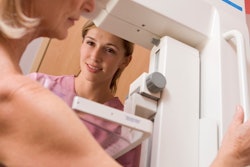
A new study from Lebanon of 2,400 women older than 40 has found that fewer than half the women underwent mammography. To overcome the hit-and-miss nature of screening adherence in the region, new campaigns and promotions are being used to encourage women from all backgrounds, according to the authors.
The open access paper, "Patterns and determinants of mammography screening in Lebanese women," by Nadia Elias, from the Faculty of Medicine at Saint-Joseph University in Beirut, Lebanon, and colleagues from the Faculty of Health Sciences at the American University of Beirut, aimed to assess mammography screening practices among Lebanese women ages 40 and older, analyze the effect of sociodemographic variables on such practices, as well as measure the association between psychosocial factors and women's screening behavior, based on data collected in 2014 via a questionnaire.
 Lebanese advertising campaigns target men as they tend to influence the behavioral choices of women. The message reads: "She reminds you of everything ... Remind her of the mammography." Retrieved from Facebook page of the campaign "Breast Cancer Lebanon." Image courtesy of Nadia Elias and Preventive Medicine Reports.
Lebanese advertising campaigns target men as they tend to influence the behavioral choices of women. The message reads: "She reminds you of everything ... Remind her of the mammography." Retrieved from Facebook page of the campaign "Breast Cancer Lebanon." Image courtesy of Nadia Elias and Preventive Medicine Reports.The authors are convinced that in order to encourage women to undergo regular screening, mammography should be made more accessible and the obstacle of cost should be removed, while the comfort of the test should continue to be improved to ensure repetition. Importantly, screening campaigns should engage directly with relatives and partners, given their major role in the behavioral choices of Lebanese women, they said.
The sample of 2,400 women included 480 (20%) from Greater Beirut and 1,920 (80%) from all other areas, with a mean age of 50 years.
A total of 105 women (4.4%) had never heard of mammography as a tool for early breast cancer detection. Among the 2,295 remaining women, 1,033 (45%; 95% CI: 43.0-47.0), had undergone mammography. Screening was significantly higher in older women, those from higher socioeconomic backgrounds, and those living in the Greater Beirut area, while it was lower in women with lower education and those who had never been married.
The key findings of the article, published online in Preventive Medicine Reports, are summarized in the following table:
| Prevalence of mammography-associated behaviors in Lebanese women (2014) (N = 2,400) | |||
| Greater Beirut | Outside Greater Beirut | Total | |
| Variable | n (%) | n (%) | n (%) |
| Ever heard | 470 (97.9) | 1,825 (95.1) | 2,295 (95.6) |
| Ever used (n = 2,295) | 253 (53.8) | 780 (42.7) | 1,033 (45.0) |
| Ever repeated (n = 926)* | 185 (76.1) | 433 (63.4) | 618 (66.7) |
| Repeated at one-year interval (n = 618) | 102 (55.1) | 262 (60.5) | 364 (58.9) |
Less than 4% of women who had undergone mammography screening reported opposition from husbands to the test, while the majority reported a neutral attitude or positive encouragement. Outside of Greater Beirut, socioeconomic status was the main factor influencing screening behavior.
Of the 1,033 women who had undergone mammography, 107 (10%) had obtained it for the first time within the 12 months preceding the survey.
Among 926 women who had the opportunity to repeat their test, 618 women (66.7%) did so. Furthermore, among these 618 women, 364 (approximately 60%) had repeated their last two tests at a 12-month interval as recommended.
Compared with women who underwent mammography once only, the study showed that women who repeated screening were significantly older, had higher socioeconomic status, and in both Greater Beirut and outside Greater Beirut, had higher levels of education. Higher perception of susceptibility for developing the disease, ease of access, and higher perception of the comfort of the previous mammography experience were also associated with repeat mammography, according to Elias and colleagues.
In terms of adherence to the recommended frequency of mammography, the sociodemographic and psychosocial variables most significantly associated with regular test repetition were: higher perception of affordability, encouragement from the husband, and higher perception of the comfort of the first test, they added.
Since 2002, annual awareness campaigns have been conducted in Lebanon to encourage a wider uptake of mammography screening and in 2009, national screening guidelines recommended annual mammography for women ages 40 and above with no family history of breast cancer.
While lifetime screening has been increasing steadily, rising from 28.9% in 2005 to 43% in 2013, regular repeat screening has increased only slightly from around 18% in 2005 to around 21% in 2013, according to the authors who point to two key obstacles to adherence: logistical determinants such as availability, screening center accessibility, and test affordability, and secondly, psychosocial factors such as values, expectations, and beliefs that prevent women from acting on their knowledge.
Future campaigns should emphasize the susceptibility of women ages 40 and older of developing breast cancer regardless of normal findings in previous screening and family history, noted the authors, whose article went online on 23 December 2016.



















